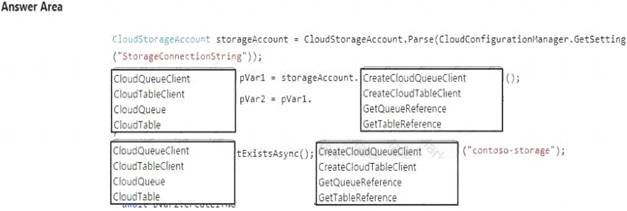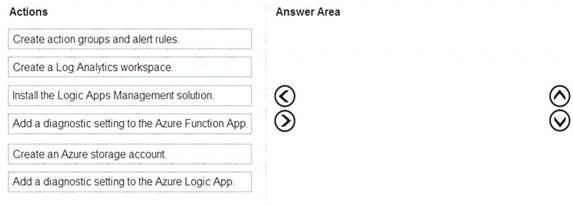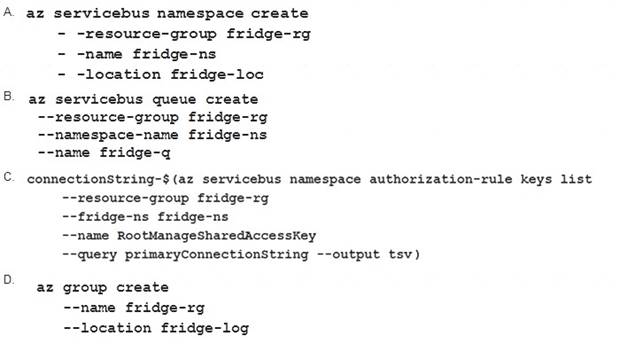- (Exam Topic 7)
You are developing a .NET application that communicates with Azure Storage. A message must be stored when the application initializes.
You need to implement the message.
How should you complete the code segment? To answer, select the appropriate options in the answer area. NOTE: Each correct selection is worth one point.
Solution:
Does this meet the goal?
Correct Answer:
A
- (Exam Topic 7)
You develop and deploy an Azure Logic App that calls an Azure Function app. The Azure Function App includes an OpenAPI (Swagger) definition and uses an Azure Blob storage account. All resources are secured by using Azure Active Directory (Azure AD).
The Logic App must use Azure Monitor logs to record and store information about runtime data and events. The logs must be stored in the Azure Blob storage account.
You need to set up Azure Monitor logs and collect diagnostics data for the Azure Logic App.
Which three actions should you perform in sequence? To answer, move the appropriate actions from the list of actions to the answer area and arrange them in the correct order.
Solution:
Text Description automatically generated
Step 1: Create a Log Analytics workspace
Before you start, you need a Log Analytics workspace. Step 2: Install the Logic Apps Management solution
To set up logging for your logic app, you can enable Log Analytics when you create your logic app, or you can install the Logic Apps Management solution in your Log Analytics workspace for existing logic apps.
Step 3: Add a diagnostic setting to the Azure Logic App Set up Azure Monitor logs In the Azure portal, find and select your logic app.
In the Azure portal, find and select your logic app. On your logic app menu, under Monitoring, select Diagnostic settings > Add diagnostic setting. Reference:
On your logic app menu, under Monitoring, select Diagnostic settings > Add diagnostic setting. Reference:
https://docs.microsoft.com/en-us/azure/logic-apps/monitor-logic-apps-log-analytics
Does this meet the goal?
Correct Answer:
A
- (Exam Topic 1)
You need to correct the VM issues.
Which tools should you use? To answer, select the appropriate options in the answer area.
NOTE: Each correct selection is worth one point.
Solution:
Backup and Restore: Azure Backup
Scenario: The VM is critical and has not been backed up in the past. The VM must enable a quick restore from a 7-day snapshot to include in-place restore of disks in case of failure.
In-Place restore of disks in IaaS VMs is a feature of Azure Backup. Performance: Accelerated Networking
Scenario: The VM shows high network latency, jitter, and high CPU utilization.
Accelerated networking enables single root I/O virtualization (SR-IOV) to a VM, greatly improving its networking performance. This high-performance path bypasses the host from the datapath, reducing latency, jitter, and CPU utilization, for use with the most demanding network workloads on supported VM types.
References:
https://azure.microsoft.com/en-us/blog/an-easy-way-to-bring-back-your-azure-vm-with-in-place-restore/
Does this meet the goal?
Correct Answer:
A
- (Exam Topic 7)
You are developing an Azure App Service REST API.
The API must be called by an Azure App Service web app. The API must retrieve and update user profile information stored in Azure Active Directory (Azure AD).
You need to configure the API to make the updates.
Which two tools should you use? Each correct answer presents part of the solution. NOTE: Each correct selection is worth one point.
Correct Answer:
AC
A: You can use the Azure AD REST APIs in Microsoft Graph to create unique workflows between Azure AD resources and third-party services.
Enterprise developers use Microsoft Graph to integrate Azure AD identity management and other services to automate administrative workflows, such as employee onboarding (and termination), profile maintenance, license deployment, and more.
C: API Management (APIM) is a way to create consistent and modern API gateways for existing back-end services.
API Management helps organizations publish APIs to external, partner, and internal developers to unlock the potential of their data and services.
Reference:
https://docs.microsoft.com/en-us/graph/azuread-identity-access-management-concept-overview
- (Exam Topic 7)
A company is developing a solution that allows smart refrigerators to send temperature information to a central location. You have an existing Service Bus.
The solution must receive and store messages until they can be processed. You create an Azure Service Bus instance by providing a name, pricing tier, subscription, resource group, and location.
You need to complete the configuration.
Which Azure CLI or PowerShell command should you run?
Correct Answer:
B
A service bus instance has already been created (Step 2 below). Next is step 3, Create a Service Bus queue. Note:
Steps:
Step 1: # Create a resource group resourceGroupName="myResourceGroup"
az group create --name $resourceGroupName --location eastus
Step 2: # Create a Service Bus messaging namespace with a unique name
namespaceName=myNameSpace$RANDOM
az servicebus namespace create --resource-group $resourceGroupName --name $namespaceName --location eastus
Step 3: # Create a Service Bus queue
az servicebus queue create --resource-group $resourceGroupName --namespace-name $namespaceName
--name BasicQueue
Step 4: # Get the connection string for the namespace
connectionString=$(az servicebus namespace authorization-rule keys list --resource-group
$resourceGroupName --namespace-name $namespaceName --name RootManageSharedAccessKey --query primaryConnectionString --output tsv)
References:
https://docs.microsoft.com/en-us/azure/service-bus-messaging/service-bus-quickstart-cli

